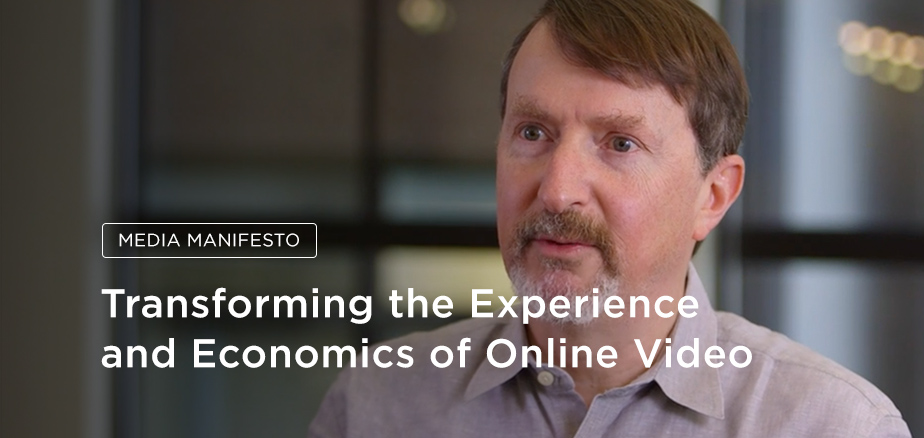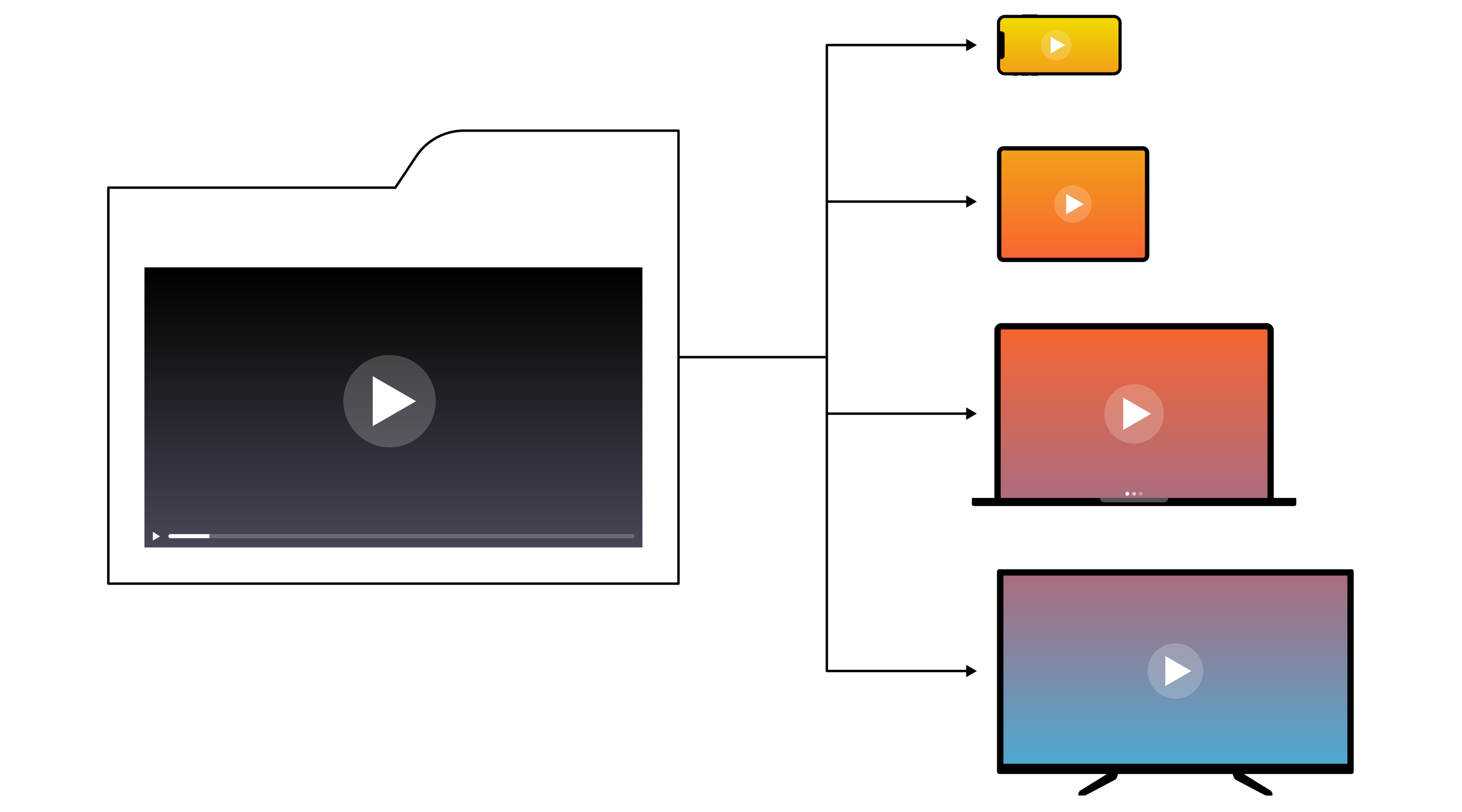Our Manifesto for Transforming the Experience and Economics of Online Video in 2017
Brightcove News

The current economics of online video publishing are not robust enough for many media companies to thrive, as more and more of the revenue and profit potential is concentrated in a small number of mega companies. In order to enable a wide range of media businesses to flourish, Brightcove has three primary mandates in 2017:
- Dramatically improve the user experience publishers can deliver to their viewers
- Increase our customers’ revenue potential from online video by as much as 50%
- Reduce the total cost of operations and delivery of online video by as much as 50% for our customers
The online video revolution has come a very long way from those early days when playing a short, low-quality, postage stamp sized video on a desktop computer in-line in a browser felt rather magical. We founded Brightcove on the vision that combining video and the open internet would change everything: every company would be a media company; every media company would be an internet company; video would be the primary data type of the internet.
At the start of 2017, that vision has been realized and we have long since “crossed the chasm.” The proliferation of amazingly capable consumer devices in our hands and our living rooms has made online video a mainstream consumer experience. The gold rush of direct-to-consumer services has led to a golden age of programming. Whole new approaches to communication, entertainment, social sharing and monetization have multiplied from YouTube to Facebook, Snapchat, Twitter, Instagram and numerous new entrants. “Traditional” media companies--companies with roots in broadcast and print publishing--have extended emphatically online and now compete for eyeballs with a wide array of “born digital” media entities. Video traffic is over 70 percent of all internet traffic and will surpass 80 percent by 2020.
However, despite this explosion of new services, vast consumer demand for online video and great content options, the fact is that the economics of many ad-supported video-on-demand (or AVOD) services are far too strained to enable sustained, healthy and growing media businesses. With the extreme concentration of ad dollars among a few mega companies (85 cents on each incremental dollar spent goes to Google and Facebook, according to Morgan Stanley), it is imperative that platform vendors and publishers come together to find a more effective way to change the economics of high quality, professional content. Otherwise, we risk transitioning from a golden age of content to a dark age of narrowing options. We can survive with fewer great serial dramas, but we shortchange our society without a sustainable business model for professional independent journalism and long-tail content creators.
For some, Subscription Video-On-Demand (SVOD) will be the path out of the economic challenge of running an ad-supported media business. Going direct-to-consumer and charging directly for one’s content can result in both a better experience than many ad-supported media options, and a healthier economic model. But this is by no means a panacea. In the U.S., we have seen strong consumer demand for the end of “the bundle,” with a desire to purchase channels a la carte. This can give content owners and service operators more friendly economics on a per-subscriber basis, but the path to success is narrow. For consumers, trying to create their own bundle through a variety of general purpose SVOD entertainment services like Netflix, Hulu and HBO, sports subscriptions like ESPN, and niche offerings like WWE, Funimation and Acorn TV, can be compelling, but only up to a point. Consumers aren’t going to buy a dozen separate services with disjointed user experiences and costs that add up fast. We may not yet know what the limit is, but it is easy to see that if we tried to convert all the content in our lives that is funded through advertising to ad-free subscription services we would quickly be spending many times more than the old bundle...and that just isn’t sustainable. And even for the SVOD services that navigate that narrow path, the economics are challenging if they can’t amass millions of viewers.
Whether you consider AVOD, SVOD or a hybrid model, it is still just too hard, too complex, too expensive to deliver great experiences. Twelve years ago, streaming HD content to wherever you were was unimaginable. If we look at the basic building blocks of online services like storage, bandwidth and computing, “the plumbing” for delivering online video has become cheaper. Yet rather than becoming easier to deliver content, it has become more complex, and largely because of the fragmentation of formats, devices, destinations (O&O properties, syndication partners, social networks). Complexity equals cost. In order for all media businesses to really thrive (and not just the top few), we need to drive a reduction of cost/complexity that is a material step function downward, not just an incremental improvement.
So, given the opportunity in front of us--again--the combination of the open internet, video, and great consumer internet devices (mobile and living room) to enable not just a golden age of content but a golden age of media businesses, here is the manifesto for our media business at Brightcove in 2017:
Radically improve the viewing experience
Increase the revenue potential for video by at least 50% over current norms
Lower the total cost of delivering great AVOD or SVOD experiences by at least 50%
There is no single silver bullet, and customers will benefit in different ways, but we know how we are going to get there. We are investing heavily in innovation and able to leverage years of investment in building a modern modular set of cloud video services, on top of a high scale public cloud infrastructure to transform the economics perhaps more in one year than we have seen since the very early days of online video. Below, I’ll crisply lay out how we are going to do that, however I encourage you to read the supporting posts that provide more specifics for each theme or to download Experience and Economics: Brightcove’s Manifesto for Media in 2017 in full.
Transforming the Viewing Experience
The data is clear. Better viewing experiences result in increased video consumption as measured by viewing time and repeat visits, which is why improving the experience is the first mandate of our 2017 Manifesto for Media. The time to load a player, the time from hitting play to first frame, and the number of rebuffering events or errors, especially when advertising is added to the mix, can have a massive impact on viewing time and return viewership.
There are four different vectors of innovation we have identified and are investing in to drive material improvements in video performance and UX that can have transformative impact for our customers in 2017.
Player load time and time-to-first-frame. The new pure HTML5 Player from Brightcove has been architected with performance as the most significant design goal, and we have attained industry-leading metrics for load time and time-to-first-frame. This is achieved through multiple aspects of the Player, from using a tiny core, to loading only what is needed, to how we optimize, compile and host the Player, to low level optimizations of how we play segmented video using Media Source Extensions (MSE). These elements are at the foundation of what makes an outstanding video player, and we will continue to drive ourselves on the performance front in 2017.
Seamless integration of advertising. We believe server-side ad insertion (SSAI) is a fundamentally better way to manage how viewers experience advertising, and with SSAI, we can deliver ads that enable a fast start, a seamless, TV-like experience with mid-rolls, and support for critical analytics. In 2017, new innovations from Brightcove will radically reduce the cost and complexity of switching from CSAI to SSAI and make this higher quality experience mainstream.
Understanding Quality of Experience. QoE Metrics enable us to understand, make transparent, and continually improve the quality of viewers’ actual video experiences. New in 2017, all of our players (Web and Native) will be instrumented with sophisticated QoE analytics beaconing and the ability to query and report to objectively understand start times, rebuffering, errors, bit rate and rendition switches.
Higher quality and more immersive new experiences. Using 4k, UHD, and 360 Degree Video will be as easy to execute as HD video is today.
Increasing Revenues
The second mandate in our Manifesto for Media in 2017 is to help our customers increase video revenue by up to 50%.
On the advertising front, the complexity driven by the expanding universe of devices on which millions of viewers consume video has brought monetization challenges and has made it impossible for one format to capably reach all platforms. At Brightcove, we deliver millions of streams a day that are monetized with client-side advertising and have led the industry in the transition away from Flash and to HTML5 video and monetization. However, in the last two years, we have seen SSAI provide a better experience and a better platform for monetization for our customers, and the business impact of these efforts is material.
We are seeing real-world increases in revenue as online video properties make the switch to SSAI. MediaWorks is New Zealand's largest independent broadcaster, reaching 96% of the population in-region through its extensive portfolio of premium brands across radio, television, digital and live platforms. Its partnership with Brightcove, and the implementation of SSAI across its properties, resulted in a 35% increase in monetizable inventory by reaching lower end devices, increasing time spent viewing, and beating ad blockers. In 2017, we want all our customers to achieve the results that MediaWorks obtained for Video on Demand, and we will also be introducing a new service to deliver the same benefits for our customers hosting live events and 24/7 live channels. Live with SSAI is a tremendous and growing opportunity for our customers and our investments in APIs for managing the ad insertion, clipping, DRM and cloud DVR capabilities will all drive inventory growth in 2017.
The second and third areas of focus for increasing revenue potential for our customers involve driving engagement and reach through recommendations and syndication.
On the engagement front, we have partnered with IRIS.TV to help our customers increase the number of premium ad impressions per viewing session and increase value of their owned and operated sites and content. A number of Brightcove customers are seeing a 50%+ uplift in views simply by turning this on. Forbes is a great example:
“Two weeks ago, we began using the IRIS.TV video player on article pages. The IRIS.TV platform uses a personalization engine to find and surface related video content based off users’ consumption habits. The early numbers for the new player have been impressive. We’ve seen a 465% lift in video views as a result of video recommendations over the last week, and 87% of users completed an experience that contained a recommended view.” [Nina Gould, Forbes Staff]
The online video ecosystem is rich and complex, providing publishers with many options, but also adding the burden of identifying tools and services, integrating, testing, maintaining, sourcing and contracting for each. The TCO of running an online video service is heavily burdened by each such integration. That is why we decided to build IRIS.TV directly into the Brightcove Player and Video Cloud as an option any of our customers can “turn on” without taking on the work and complexity of sourcing, contracting and integrating. ROI is high, cost of adoption is low.
Syndication is another opportunity for monetization that successful online video businesses are increasingly leveraging. Inbound video syndication of high quality content creates new inventory to monetize, and keeps viewers on-site. Outbound video syndication offers publishers more return from their content investments. Until recently, both were complex to get started, required multiple systems, and were only really available to larger companies that had the staff to manually set up and manage syndication businesses. The Brightcove Marketplace makes this easy. For Video Cloud customers, selecting the videos, players, and business rules they wish to employ when syndicating content out, and augmenting their libraries with content from the marketplace, are both straightforward processes. Additionally, the challenges of tracking, analytics and transaction settlement are removed from our customers’ shoulders. This is a big leap forward in flexibility and opportunity from the models that the market has offered to date.
Reducing Cost and Complexity
We have been hard at work on some foundational elements of video workflow and packaging that will measurably benefit our customers in 2017.
Modern media workflows now require many different types of content processing; tasks like the application of digital rights management (DRM), the markup and preparation of video files for ad insertion or their distribution to social networks like Twitter, Facebook and YouTube. Maybe a customer requires the tagging of content for ease of management in the context of the different subscription packages that comprise its OTT service. At their core, these workflows must be able to properly process and package each individual stream for the appropriate user and platform. This is often referred to as stream conditioning. At Brightcove, we call our ability to do this Dynamic Media Delivery. This innovation will fundamentally change a number of things for our customers - most favorably in their cost of operation, through not having to manage disparate elements that perform these functions separately and with additional, per solution costs. Customers delivering premium content with DRM and targeting multiple devices will see the most dramatic benefits, as we reduce the number of renditions of each video required from as many as 50-100 down to fewer than 10, slashing costs associated with transcoding and storage.
Also helping us get to the 50% savings goal in the areas of storage and delivery will be Brightcove Dynamic Profiles. Today, Brightcove’s Video On Demand (VOD) customers use a set of predetermined video delivery profiles, which contain static bitrate specifications regardless of asset type, to deliver their video content to consumers. We view this as being less than efficient. In fact, we believe that doing so creates inefficiencies that result in 30% to 40% higher storage and delivery costs than necessary, and so, we soon will employ machine learning to do content analysis that informs a better, more effective way of processing it.
Other key pieces of the cost savings equation include:
Brightcove Social’s streamlined native publishing capabilities for Facebook, YouTube and Twitter being inside Video Cloud. The process is now fast, simple and inexpensive, especially for those customers who had been paying for extra tech for this workflow. The 2017 roadmap for Social has a slew of features to increase the initial efficiencies our customers have discovered.
Brightcove OTT Flow powered by Accedo is proving to be a robust and cost-efficient product that can make viable – across iOS/Android/FireTV/Roku/AppleTV – even offerings that serve more niche audiences.
The sum of these items is market-shifting. In 2017, we will enable customers to reduce silos, eliminate custom work and cumbersome integration projects, lower storage and delivery costs, and shorten time-to-market.
Summary and Next Steps
2017 will be a breakthrough year for many online video services and publishers. At Brightcove, innovations we have been working on for a long time will come together to achieve our mandate:
Deliver radically better user experiences
Faster load times and time-to-first-frame
Seamless and fast ad playback across devices
Higher quality and more immersive video, delivered with fewer errors and rebuffering events
Increase revenue potential from online video by as much as 50%
SSAI will unlock 30%+ inventory by solving the challenges of device reach, user experience, and ad-blockers; while becoming lower cost and easier to adopt for both VOD and Live
Recommendations built into Video Cloud and the Brightcove Player, powered by IRIS.TV will drive as much as 50%+ incremental video views
Outbound syndication using the Brightcove Marketplace will enable new revenue streams, and inbound syndication will create new inventory with high quality content from many of the leading online video content creators
Decrease Total Cost of Ownership by as much as 50%
Brightcove Dynamic Media Delivery will reduce technical silos and costs associated with transcode and storage, especially for premium content services requiring DRM
Brightcove Social will reduce the effort and other costs associated with uploading content separately to each major social network and aggregating analytics
New machine learning-powered encoding technology, Dynamic Profiles, will reduce the bandwidth and storage required for an online video service by as much as 30-50% without any reduction in quality
OTT Flow will let media companies rapidly launch beautiful new OTT services with no upfront costs, and low, predictable monthly costs
Brightcove's concentration on these three themes results from dozens of conversations and briefings that we have had with customers around the world over the past year. We are privileged to work with an accomplished set of teams from media companies that are forging paths for their businesses in a rapidly evolving and often challenging video landscape. For this manifesto, we knew we owed them not just an articulation of where we think we can make a difference in their trajectories, but also the specifics of how to achieve that. Do our priorities align? We look forward to seeing the results of our collective efforts in 2017 and beyond.


